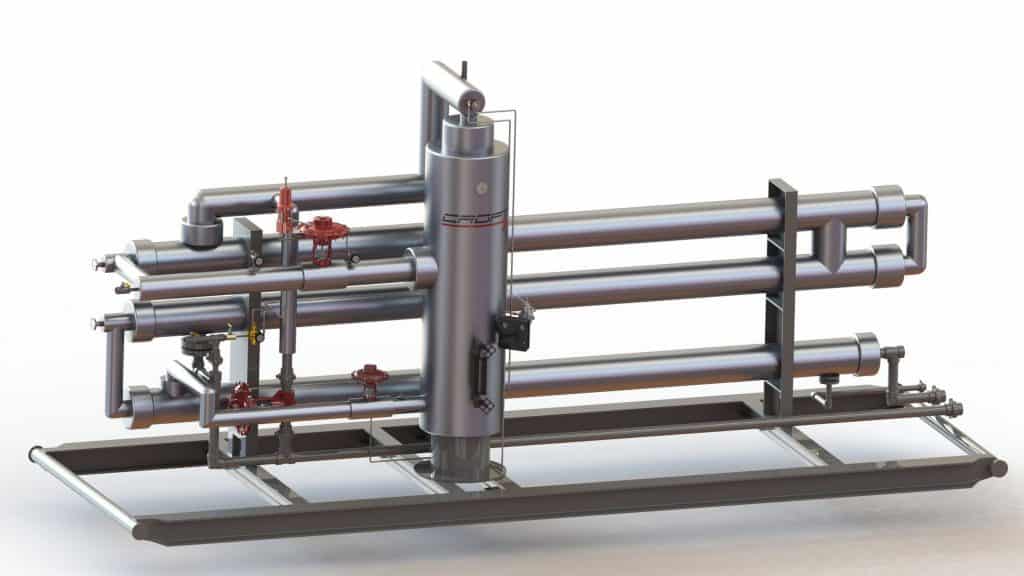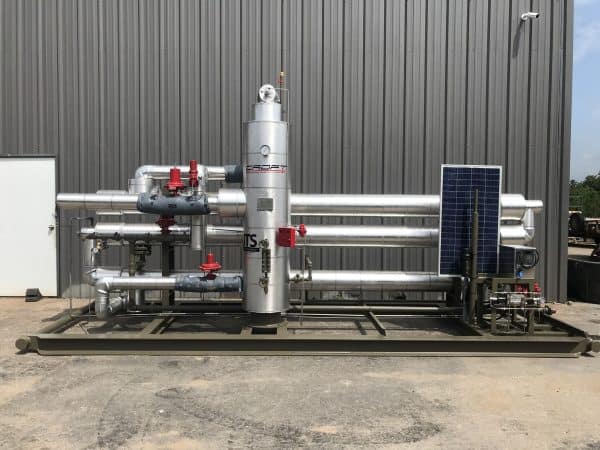JT Systems are primarily used for three different applications, NGL recovery, dew point specification, and BTU reduction. In this video, Chris Smithson, Director of Engineering, will describe those applications and go over the process of a JT System.
Video Transcript:
Hi, I’m here with Chris, Director of Engineering, for Croft Production Systems. Today will be talking about a Joule Thomson System, also known as a JT System. Chris, tell us what a JT is…
What is a JT System and What applications is it used for?
JT systems, like the one seen here, are primarily used for three different applications. The first being NGL recovery, which is the removal of the in NGLs, for an additional revenue source. The second is dew point specification for pipeline spec. nd, the third application is the reduction of the BTUs of the natural gas for natural gas-powered engines.
How Does Croft Jt Design Work?

JT-Systems are rather simple pieces of equipment. The gas will come in at the end of the skid, then the gas will go through a gas-to-liquid heat exchanger, which is this exchanger here at the bottom of the unit. The gas will be pre-chilled and then go into the gas-to-gas exchanger, where the temperature will drop further. The gas will go all the way through this gas-to-gas exchanger, and then into this JT valve which is just a pressure reduction valve. This will take high-pressure gas; drop the pressure, and then use that pressure drop as a chilling effect to reduce the temperature of the gas, and start creating liquids. The liquids that will be collected are Hexanes, Pentanes, Butanes, and Propane, and they will be collected into the cold separator. We then dump those liquids into our gas-to-liquid heat exchanger to use those cold liquids as the ling medium for that natural gas. The BTU-reduced gas will exit the cold separator, go into the gas-to-gas separator, where it uses that cold temperature to prechill incoming gas. et’s take a look at a simplified flow diagram of the JT System to get a better idea of how the liquids and gases flow through the system. Rich hot gas enters the liquid to the heat exchanger, where it is cooled by cold NGLs coming from the cold separator. The rich gas will then continue to the gas-to-gas heat exchanger, where it is cooled by lean cold gas, coming from the cold separator. The gas will then go through a JT valve where it takes a pressure drop. We will use the chilling effect that pressure drop to chill down the gas and ultimately reach our cold separator temperature. The cold gas will then go into the separator where the liquids are separated out of the gas. The liquids will fall to the bottom of the separator and be dumped down into the liquid-to-gas heat exchanger where the cold fluids are used to cool the incoming hot gas. The lean gas, that is separated in the cold separator, is then sent to the gas-to-gas heat exchanger where it cools the incoming rich gas from the system. The gas then leaves the system.
Why do we recommend a high-efficiency heat exchanger?
A high-efficiency heat exchanger is going to allow us to get the most out of the pressure drop that we are going to have. So if we can recover as much of that cooling effect then we can get even cooler in our cold separator with the least amount of pressure drop.
Why does insulation matter?
The insulation is very important. Because this unit is getting very cold, we want to be able to keep that cold in the system. Also, because it is out in the in the environment, we want to be able to keep radiant heat and ambient temperatures out of the system, as well. That way we can maintain the performance of the unit.
What does a hot gas bypass do?
A hot gas bypass allows us to maintain a temperature within the system. If the unit gets too cold the hot gas bypass will open up and limit the cold temperature that the unit can achieve, that way we stay within the rated design temperature of the system.
What is a methanol pump used for?
The methanol pump is used to inject methanol into the JT system. Methanol injection is required to make sure there’s no hydrates that occur within the system which could plug off the flow.
What kind of maintenance is required on a JT System?
JT Systems are very simple units. The operator just needs to check to make sure that we are maintaining our cold temperature and then check the other controllers and valves on the unit to make sure they’re operating properly.
What do you do with the NGLs?
Typically, the NGLs are sent to a pressurized storage tank on location. There they’ll wait for a truck to come and take them away as an additional revenue source. If the applications is for fuel gas, a lot of times, the NGLs aren’t recovered and will just be sent to a low pressure separator.
What standard sizes do Croft Systems come in?
While we can build a custom application for whatever the client parameters are, our standard package skid units come in to two-million, five-million and 10-million cubic-feet-a-day packages.
Thank you, Chris, for walking us through a JT system. If you have additional questions or want to learn more about our JT Systems, you can visit us at, www.CroftSystems.net or you can call us at 979-793-2100.












